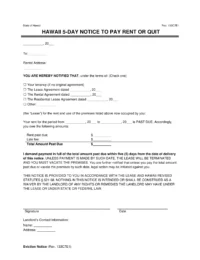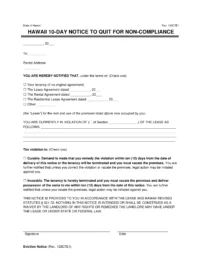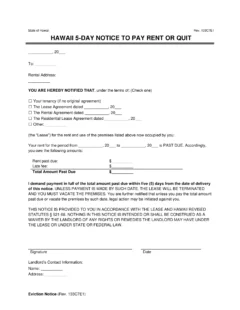

A Hawaii eviction notice is a legal document completed by landlords or property managers to address tenant violations such as unpaid rent, lease breaches, or illegal activities. The notice outlines the issue and specifies the number of days the tenant has to rectify it. If the tenant fails to comply, the next step is filing an eviction lawsuit. Following the state’s specific legal requirements for eviction notices is crucial to ensure the process is valid and enforceable.

Begin evicting a tenant if they haven’t paid rent on time.

Give tenants ten days to fix (or “cure”) the problem before eviction can proceed in court.

Inform the tenants to move out if they’re on a month-to-month lease.
Evictions in the state are governed by Hawaii Residential Landlord-Tenant Code Chapter 521.
Before the eviction process begins, a landlord may want to give their tenant a late rent notice, which encourages them to correct their rental agreement violation. If this doesn’t work, the landlord may have to evict their tenant(s).
Landlords must provide the tenant with the correct eviction notice type. At this step, it’s possible that the tenant and landlord will agree on the tenant moving out, in which case they can skip the last steps and use a lease termination letter.
If the tenant fails to correct their violation or respond to the eviction notice, the landlord may file a summons and complaint with the district court in their county. This comes with a filing fee of $155.00, and the landlord must include a copy of the lease and eviction notice that they served the tenant.
A process server, licensed in Hawaii, must deliver the summons and complaint to the tenant. The tenant then has five days after receiving the summons to respond.
If the tenant doesn’t respond, the court issues a ‘writ of possession.’ This allows the landlord to have a police officer remove the tenant and their possessions from the property.

Create Your Hawaii Eviction Notice in Minutes!